|
Chapter II
Life on the Jersey shore was lively, with four exuberant
daughters to keep both Ted and Cecil quite busy. Decades later, Budgie
(my mother, Margery) told me of times the girls spent on a little
sailboat named the Teddy Bear. In teenage years, their summer days on
the Manasquan River were delightful, with many friends, boat racing and
general good times The ocean just two miles away offered other
adventures. They swam, played, ran in the sand and fished with their
father. On shopping days, transportation was a small horse and an open
wagon. Winters were mild with enough snow for sledding and ice ponds for
skating. The woods on all sides were filled with holly trees covered
with deep green, thorny leaves and bright red berries.
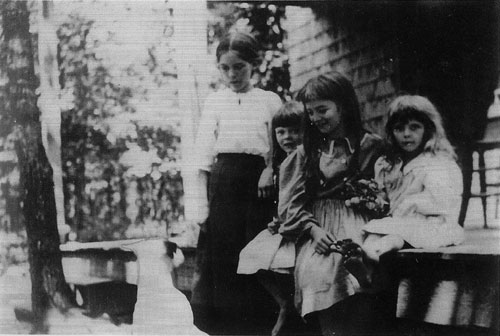 |
|
The four Boulton daughters,
1904. |
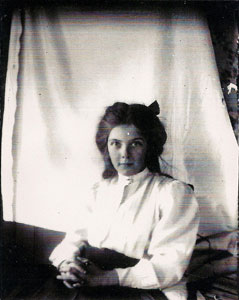 |
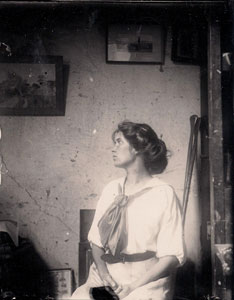 |
| Margery
Boulton, 1904. |
Agnes
Boulton, 1904. |
The girls adored their father and lovingly called him
Teddy. They helped with chores, feeding chickens and carrying wood. They
laughed with Ted over his funny stories and jokes and were amused with
the catchy jingles he sang. They saw a cheerful man who seemed fulfilled
with his art, his family and many friends.
At one point, Ted and Cecil decided they needed more
space for this large family. Ted designed an extension with two large
rooms, one over the other, at the east end of the house, and had them
built by a man named Frank Bennett. The lower room became the nursery
and the upstairs was the master bedroom. The rooms were still called the
nursery and master bedroom when Oona and I were growing up. Each of the
large rooms had five windows bringing in the bright morning sun. Later
on, the upper room became Aggie’s bedroom and study where she wrote, and
the lower room became a playroom-bedroom for Oona.
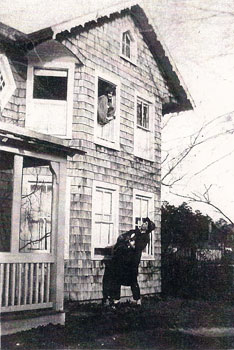 |
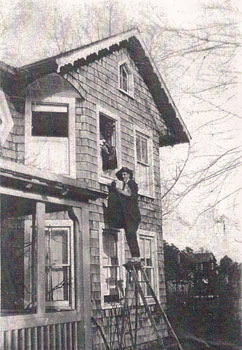 |
|
Ted having fun on the new wing
of Old House, 1890s. |
On the back of the house Ted had included a spacious
studio with a corner for his easel, and wall space for the paintings as
he finished them. For all the years we were growing up there, his spirit
seemed to always be in that room, with the north light coming in through
a huge skylight on the roof. As children, Oona and I loved being in
there more than any other room in the house. We would listen to records,
dance and sing, play games and read, sitting on the puffy, comfortable
couch that took up part of one wall. Teddy’s easel remained, standing in
the corner.
Ted or Edward W. Boulton, a prolific artist best known
for his impressionist landscapes, had also gained a reputation for
exquisite miniature portraits. We know of only two remaining. One is of
his daughter Agnes as a young woman. Agnes' granddaughter, Victoria
Chaplin Théirrée, has it in her home in France. The other, a picture of
Cecil, remains with her great grand-daughter, Maura O’Neill Jones.
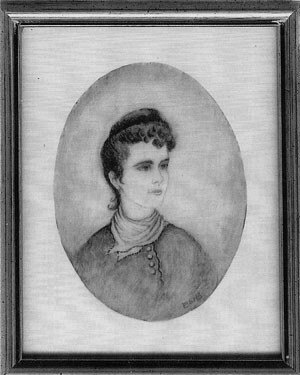 |
Miniature of
Cecil, 1890s. Photographer E.W. Boulton. |
Weekends in the early 1900s often brought Thomas Eakins
and several students from the Philadelphia Art Students League to the
Jersey shore to visit with Cecil and Ted. They rode bicycles over the
dirt roads, on the long trip across Jersey.
After the group settled themselves in at The Old House
they might pitch in to help Ted with one project or another. One such
time was when he was putting up a windmill to pump water. There were
many laughs as they struggled awkwardly to raise the giant flaps on the
ungainly structure. There was much pushing and pulling until finally the
test came and it worked! They cheered, watching the wind catch the
clumsy paddles as they began to turn. The old windmill stood for many
years, bringing fresh, cool water into the house, while the family
enjoyed hearing the great, creaking paddles catch in the wind.
Weekend evening dinners with those close friends were
invariably followed by folksongs and tunes played on a banjo, guitar or
ukulele. Teddy strummed on the guitar and might start a round of sea
chanteys or a few bawdy ballads. Young Cecil liked sitting in and
learning the words to sing along. In later years, as an adult, she
thought it fun to shock family and friends by recalling a verse or two
of what she called “the naughty songs.” It was even more delightful
because of her innocent expression.
Agnes, in a letter to Oona, told an amusing, but
distressing, story about Frank Bennett when he felt that grandfather Ted
was having a little financial trouble and
wanted to help. He thought perhaps he and Ted could raise cocks for
fighting and enter them in some of the local cock fights. Agnes wrote:
“Frank arrived late one night, his fingers on his lips, carrying a
burlap bag in which he had a beautiful and expensive cock that he had
purchased that day at a poultry show. He put it on the dining room table
and I remember we children hanging over the stairs, listening to the
whispering and Frank's excited steps. We could see it there, very
ruffled and annoyed, but bewildered in the kerosene lamplight. My poor
father did not know what to do, and for the night put the bird inside
the chicken yard, thinking no doubt, it would be safe until morning when
he could build it a pen. Going out there about six in the morning, he
told us he found only the game cock, defiantly walking about, surrounded
by dead bodies. The cock had destroyed every chicken, hens and all,
about thirty of them. Either during the night, or when dawn broke, this
proud rooster had found himself in the barnyard of common white
leghorns. Not a sound was ever heard either, so nothing ever came of
making money with this game cock. And that ended that.” The family knew
that Ted couldn't really bring himself to take such a beautiful bird to
a cock fight!
Frank Bennett also helped Ted to build a small studio,
and another house called “The House in the Woods” and the family found
themselves living in one or another of the three houses. No one really
knew why. The House in the Woods was eventually sold for $800 and rolled
on rollers down the Herbertsville Road passing The Old House and the
studio on the way. Two blocks down the road it became known as The
Antique Shoppe.
Mother Cecil was one who allowed herself to be a
caretaker, not only of everyone in the immediate family, but also of
their children in later years. She was known in West Point Pleasant for
her kindness, and became the self-appointed local midwife. When a young
neighbor was about to give birth, Cecil would trudge down the road with
her small leather bag, staying all night if necessary. She also took
turns helping those who were ill.
Cecil, though being a caretaker above everything, often
longed for a time to write poetry, and to study whatever was available
about theosophy. She had been stimulated by her mother’s interest in
these subjects. I found, later on, old notebooks with poetry and
philosophical musings jotted down from long years before. She often
walked around the house reciting poetry in French or English which duly
impressed us all. Cecil spoke French fluently and played the piano,
singing in a deep, rich voice as she accompanied herself. These were the
times she seemed most happy.
Agnes Ruby Boulton, as a small child, had been sent to a
parochial school in Philadelphia. Her mother, having become enamored
with the Catholic Church when she was living in Philadelphia, had
promised that Agnes would go to the school for part of her childhood.
After the family moved to New Jersey, Agnes in her teens, returned to
the city to study art. She quickly learned that art was not her calling,
and it wasn’t long before she decided the most important creative
activity for her was writing. She went home to West Point Pleasant again
and spent months working on this new venture. Eventually she began
taking trips to New York City to find publishers who might be interested
in her work.
It was 1908 and Agnes was only sixteen when she
submitted a story to a popular magazine. It was accepted and published,
and this seemed the most exciting moment of her life. She had sold it to
The Smart Set, a literary magazine published by George Jean Nathan and H.L. Mencken, and immediately she wrote and submitted a second, as the
family cheered her on.
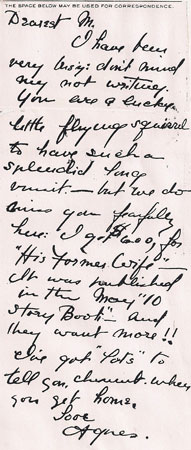 |
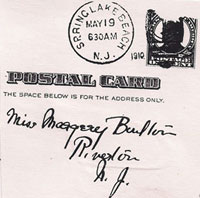 |
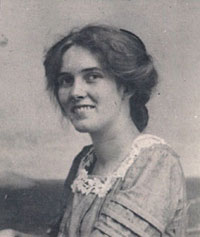 |
|
Postcard to Margery from
Agnes. Agnes at age 16, 1908. |
Agnes sold more stories to The Smart Set and to several
pulp papers and magazines, including one of the Frank Munsey*
newspapers. Her sister, Margery saved this one for eighty years and
passed it on to me to share with the rest of the family.
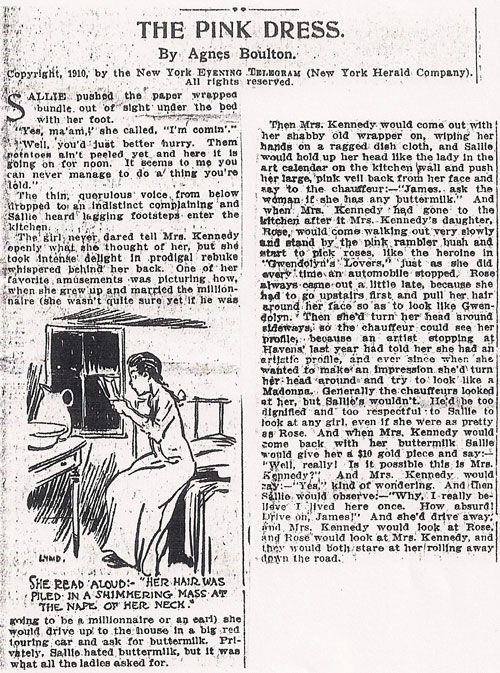 |
| “The Pink
Dress” (partial) by Agnes Boulton, New York Evening
Telegram, 1910. |
When one of Teddy's Philadelphia aunts died, Agnes found herself with an
unexpected inheritance. She had been named for her great aunt Agnes and
at age twenty-one a small amount of money and some prized furniture were
left to her. Ted and Cecil were in financial trouble and Agnes bought
The Old House to help them through this difficult period. Agnes lived in
the city a great deal of the time, while Ted and Cecil continued to stay
in The Old House in West Point Pleasant where they rightly felt most at
home.
 |
Deed to The
Old House from Boultons to Agnes, 1913. |
*Frank Munsey was a
well-known newspaper publisher who presented The Sun in 1916,
followed by The Evening Mail, The Evening Telegram, and
The New Evening Sun. He was considered the greatest newspaper
magnate of his day.
 Chapter III
Chapter III |